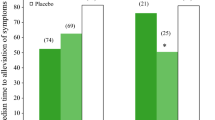Abstract
Objective
The objective of these studies was to examine the clinical pharmacokinetics and safety of zanamivir, an influenza A and B virus neuraminidase inhibitor, when administered to healthy volunteers.
Design
The safety, tolerability and pharmacokinetics of zanamivir administered by a number of routes were assessed in randomised, double-blind and placebo-controlled studies. The study of absolute oral bioavailability had an open design.
Study participants
The participants in these studies were healthy male or female volunteers.
Interventions
Zanamivir was administered as single or multiple doses by the intravenous, oral, inhaled (nebuliser and dry powder) and intranasal routes. Serum and urine samples were obtained for determination of pharmacokinetic parameters, and nasal washes and throat gargles were performed to assess drug concentrations in the nose and throat. Safety was evaluated by monitoring adverse events, vital signs and laboratory parameters.
Results
Zanamivir was well tolerated at all doses by all routes; no serious adverse events were reported. The kinetics of zanamivir were linear with single intravenous doses up to 600mg, and there was no evidence of modification in the kinetics after repeated twice-daily administration. Approximately 90% of zanamivir was excreted unchanged in the urine. The elimination of zanamivir from the serum was a first-order process with a half-life of approximately 2 hours and, at 16L, the volume of distribution was similar to that of extracellular water.
The absolute oral bioavailability of zanamivir was low, averaging 2%. After intranasal or oral inhaled administration, a median of 10 to 20% of the dose was systemically absorbed, with maximum serum concentrations generally reached within 1 to 2 hours. The median serum half-life ranged between 2.5 and 5.05 hours, suggesting that the elimination rate is limited by absorption. There was no evidence of modification in the kinetics after repeated inhaled administration.
Conclusions
Zanamivir is a well tolerated drug. The low level of absorption of the drug after inhaled administration results in low serum concentrations, and therefore there is modest systemic exposure to zanamivir after inhalation. Zanamivir is not metabolised, and the potential for clinically relevant drug-drug interactions is very low.
Similar content being viewed by others
References
Von Itzstein M, Wu W-Y, Kok GB, et al. Rational design of potent sialidase based inhibitors of influenza virus replication. Nature 1993; 363: 418–23.
Whittington A, Bethell R. Recent developments in the antiviral therapy of influenza. Expert Opin Ther Patents 1995; 5: 793–803.
Woods JM, Bethell RC, Coates JAV, et al. 4-Guanidino-2,4-dideoxy-2,3-dehydro-N-acetylneuraminic acid is a highly effective inhibitor both of the sialidase (neuraminidase) and of growth of a wide range of influenza A and B viruses in vitro. Antimicrob Agents Chemother 1993; 37: 1473–9.
Daniel MJ, Barnett JM, Pearson BA. The low potential for drug interactions with zanamivir. Clin Pharmacokinet 1999; 36 Suppl. 1:41–50.
Gibaldi M, Perrier D. Pharmacokinetics. 2nd ed. New York: Marcel Dekker, 1982.
Kaulbach HC, White MV, Igarashi Y, et al. Estimation of nasal epithelial lining fluid using urea as a marker. J Allergy Clin Immunol 1993; 92(3): 457–65.
Newman SP, Pavia D. Aerosol deposition in man. In: Moren F, Newhouse MT, Dolovich MB, editors. Aerosols in medicine: principles, diagnosis and therapy. Amsterdam: Elsevier Science, 1985:289–312.
Newman SP, Clarke SW. Aerosols in therapy. In: Moren F, Newhouse MT, Dolovich MB, editors. Aerosols in medicine: principles, diagnosis and therapy. Amsterdam: Elsevier Science, 1985: 193–217.
Cass LMR, Efthymiopoulos C, Marsh J, et al. Effect of renal impairment on the pharmacokinetics of intravenous zanamivir. Clin Pharmacokinet 1999; 36 Suppl. 1: 13–9.
Calfee DP, Peng AW, Cass LM, et al. Safety and efficacy of intravenous zanamivir in preventing experimental human influenza A infection. Antimicrob Agents Chemother. In press.
Peng A, Hussey B, Moss J. AGG167 pharmacokinetic study to select a regimen for prophylaxis. Research Triangle Park: Glaxo Wellcome, RM 1997/00419/00.
Calfee DP, Peng AW, Hussey EK, et al. Safety and efficacy of once daily intranasal zanamivir in preventing experimental human influenza A infection. Antiviral Ther. In press.
Cass LMR, Brown J, Pickford M. Pharmacoscintigraphic evaluation of lung deposition of inhaled zanamivir in healthy volunteers. Clin Pharmacokinet 1999; 36 Suppl. 1: 21–31.
Bergstrom M, Cass LMR, Valind S, et al. Deposition and disposition of [11C]zanamivir following administration as an intranasal spray: evaluation with positron emission tomography. Clin Pharmacokinet 1999; 36 Suppl. 1: 33–9.
Author information
Authors and Affiliations
Rights and permissions
About this article
Cite this article
Cass, L.M.R., Efthymiopoulos, C. & Bye, A. Pharmacokinetics of Zanamivir After Intravenous, Oral, Inhaled or Intranasal Administration to Healthy Volunteers. Clin Pharmacokinet 36 (Suppl 1), 1–11 (1999). https://doi.org/10.2165/00003088-199936001-00001
Published:
Issue Date:
DOI: https://doi.org/10.2165/00003088-199936001-00001




